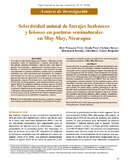| dc.contributor.author | Velásquez Vélez, Raúl | |
| dc.contributor.author | Skarpe, Christina | |
| dc.contributor.author | Ibrahim, Muhammad Akbar | |
| dc.contributor.author | Mora, Jairo | |
| dc.contributor.author | Benjamín, Tamara | |
| dc.contributor.editor | Pezo Quevedo, Danilo | es_ES |
| dc.date.accessioned | 2015-03-19T22:09:05Z | |
| dc.date.available | 2015-03-19T22:09:05Z | |
| dc.date.issued | 2009 | |
| dc.identifier | 473920 | es_ES |
| dc.identifier.issn | 1022-7482 | es_ES |
| dc.identifier.uri | https://repositorio.catie.ac.cr/handle/11554/6804 | |
| dc.description | 8 tablas | es_ES |
| dc.description.abstract | Se evaluó la selectividad animal por forrajes a diferentes escalas jerárquicas (sitios de alimentación y especies individuales) en dos paisajes (planicies onduladas y vegas de ríos) y dos tipos de manejo (vacas lactantes y ganado horro) durante la época seca y lluviosa. Se evaluaron tres tratamientos: vacas lactantes en vega, vacas lactantes en planicies onduladas y ganado horro en planicies onduladas, con ocho repeticiones por tratamiento. La composición botánica de los sitios de pastoreo difirió de la media de los potreros. El índice de selectividad (IS) de las especies varió con los tratamientos y épocas. En la época seca, varias leñosas mostraron IS más altos que las gramíneas y otras especies herbáceas, pero en ambas épocas, las gramíneas hicieron un mayor aporte a la dieta (83,1 y 70,6%, respectivamente). Con los resultados obtenidos se corrobora la hipótesis de que los animales seleccionan su alimento a diferentes escalas espaciales. | es_ES |
| dc.description.abstract | Forage selectivity by grazing animals at different hierarchical levels was evaluated under two landscape conditions (undulated lands and riverbanks) and two animal management regimes (lactating and dry cows) during the dry and wet seasons. Three treatments were studied:lactating cows on riverbanks, lactating cows on undulating lands and dry cows on undulating lands, each with eight paddocks as replicates. Botanical composition of grazed areas differed from the mean for each paddocks. Selectivity indexes (SI) for individual species varied according to treatment and season. During the dry season, several woody perennials showed higher SI than grasses and other herbaceous species, but grasses made a greater contribution to the diet than the woody perennials in both seasons (83.1 and 70.6% in the wet and dry season, respectively). Results obtained in this study confirm the hypothesis that grazing selectivity differs spatially. | en_EN |
| dc.format.mimetype | pdf | |
| dc.language.iso | es | es_ES |
| dc.publisher | CATIE, Turrialba (Costa Rica) | es_ES |
| dc.relation.ispartof | Agroforestería en las Américas, número 47 (2009), páginas 51-60 | |
| dc.rights | info:eu-repo/semantics/openAccess | es_ES |
| dc.rights.uri | https://creativecommons.org/licenses/by-nc-nd/4.0/ | |
| dc.subject | TIERRAS DE PASTOREO | es_ES |
| dc.subject | PLANTAS FORRAJERAS | es_ES |
| dc.subject | COMPOSICION BOTANICA C | es_ES |
| dc.subject | OMPOSICION APROXIMADA | es_ES |
| dc.subject | PREFERENCIAS ALIMENTARIAS | es_ES |
| dc.subject | ESTACION HUMEDA | es_ES |
| dc.subject | ESTACION SECA | es_ES |
| dc.subject | GANADO BOVINO | es_ES |
| dc.subject | NICARAGUA | es_ES |
| dc.title | Selectividad animal de forrajes herbáceos y leñosos en pasturas seminaturales en Muy Muy, Nicaragua | es_ES |
| dc.title.alternative | Assessment of animal selection on herbaceous and woody plants in seminatural pastures in Muy Muy, Nicaragua | es_ES |
| dc.type | Artículo | es_ES |
| dc.journal.issueNumber | 47 | |
| dc.journal.pages | 51-60 | |



